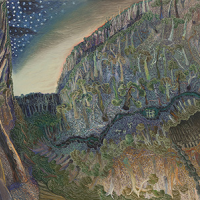WILLIAM ROBINSON, Day and Night Landscape

Observing the progress of William Robinson’s art is like operating the zoom function on a camera; but in reverse. From his earliest demure interiors and the studies of domestic life in the Robinson household, his vision and his focus expand gradually, over time, to take in the views through the windows to outside, to his garden, the yards, paddocks, and bush, to the distance, Australia, and the cosmos. The sublime landscapes which became the destination for this progress are now his best known work. These landscapes hang in Museums, Galleries, Collections Public and Private all over Australia and elsewhere. His standing in the Australian Art community – he is arguably the most important painter working in this country right now – is based on the beauty and originality of his vision of the Australian landscape. Robinson is the successor to Eugene von Guérard, Tom Roberts, Arthur Streeton and Fred Williams. Like these historical figures he is a painter working on the subject that is essentially Australian, its landscape. He has set about solving the unique problems that it presents to artists wishing to capture its special qualities. Robinson’s approach to the subject is in keeping with his appreciation of his place in subject’s artistic lineage.
Along the way his vision and the style he worked in evolved. In the late 1980s, it was the goings-on of his farm animals drew his interest. His paintings of barnyard politics of cows and chooks are choreographed and sophisticated as well as being quite earthy. They remain amongst his best loved works. As the broader landscape itself starts to command his interest, however, the farm’s role in the greater scheme of things changes. The key moment in his development, which took place in the late 1980s, occurs when we start to see the earth, forest, and the sky from the viewpoint of a person lying flat on the ground. With the trees reaching upwards into the sky, as seen from below, Robinson rolled the landscape on its side and subjected it to the kind of examination you can undertake when you are alone, relaxed and in repose.
Night and Day belongs to the period when Robinson’s vision enters a philosophical phase, when the spirituality of the bush takes over from its domestication. The cows, a final trace of man’s activity, fade as dusk draws a veil over the scene. The capacity of a landscape to inspire thoughts of magic and mystery is now Robinson’s inspiration. As the paintings evolve through the 1990s into these remarkable views, which combine the awe of distance and the close intimacy of the understory, where leaves, branches, clouds, sunbeams and showers and stars contribute the final element, he succeeds in his quest of rendering the sublime. These paintings, although as stylised as anything by William Blake or Samuel Palmer, are nevertheless thoroughly convincing as depictions of the part of the country he knows best.
Timothy Abdallah BA (Hons)